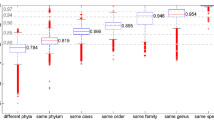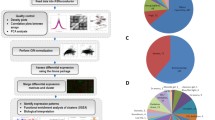Abstract
A comparison of 8 cyanobacterial genomes reveals that there are 181 shared genes that do not have obvious orthologs in other bacteria. These signature genes define aspects of the genotype that are uniquely cyanobacterial. Approximately 25% of these genes have been associated with some function. These signature genes may or may not be involved in photosynthesis but likely they will be in many cases. In addition, several examples of widely conserved gene order involving two or more signature genes were observed. This suggests there may be regulatory processes that have been preserved throughout the long history of the cyanobacterial phenotype. The results presented here will be especially useful because they identify which of the many genes of unassigned function are likely to be of the greatest interest.
Similar content being viewed by others
References
Amard B and Bertrand-Sarfati J (1997) Microfossils in 2000 Ma old cherty stromatolites of the Franceville Group, Gabon. Precambrian Res 81: 197–221.
Brasier MD, Green OR, Jephcoat AP, Kleppe AK, van Kranendonk MJ, Lindsay JF, Steeles A and Grassineau NV (2002) Questioning the evidence for Earth's oldest fossils. Nature 416: 76–81
Brocks JJ, Logan GA, Buick R and Summons RE (1999) Achaean molecular fossils and the early rise of eukaryotes. Science 285: 1033–1036
Catling DC, Zahnle KJ and McKay C (2001) Biogenic methane, hydrogen escape, and the irreversible oxidation of early Earth. Science 293: 839–843
Doolittle WF (1999) Lateral genomics. Trends Cell Biol 9: M5–M8
Fitz-Gibbon ST and House CH (1999) Whole genome-based phylogenetic analysis of free-living microorganisms. Nucleic Acids Res 27: 4218–4222
Gaasterland T and Ragan MA (1998) Constructing multigenome views of whole microbial genomes. Microb Comp Genomics 3: 177–192
Graham DE, Overbeek R, Olsen GJ and Woese CR (2000) An archaeal genomic signature. Proc Natl Acad Sci USA 97: 3304– 3308
Hall TA (1999). BioEdit: a user-friendly biological sequence alignment editor and analysis program for Windows 95/98/NT. Nucleic Acids Symp Ser 41: 95–98
Hihara Y, Kamel A, Kanehisa M, Kaplan A and Ikeuchi M (2001) DNA microarray analysis of cyanobacterial gene expression during acclimation to high light. Plant Cell 13: 793–806
Higgins D, Thompson J, Gibson T Thompson JD, Higgins DG and Gibson TJ (1994) CLUSTAL W: improving the sensitivity of progressive multiple sequence alignment through sequence weighting, position-specific gap penalties and weight matrix choice. Nucleic Acids Res 22: 4673–4680
Huynen M, Snel B, Lathe W and Bork P (2000) Predicting protein function by genomic context: quantitative evaluation and qualitative inferences. Genome Res 10: 1204–1210
Itoh T, Takemoto K, Mori H and Gojobori T (1999) Evolutionary instability of operon structures disclosed by sequence comparisons of complete microbial genomes. Mol Biol Evol 16: 332–346
Jain KK (1999) Strategies and technologies in functional genomics. Drug Discov Today 4: 50–53
Kaneko T, Nakamura Y, Wolk CP, Kuritz T, Sasamoto S, Watanabe A, Iriguchi M, Ishikawa A, Kawashima K, Kimura T, Kishida Y, Kohara M, Matsumoto M, Matsuno A, Muraki A, Nakazaki N, Shimpo S, Sugimoto M, Takazawa M, Yamada M, Yasuda Mand Tabata S (2001) Complete genomic sequence of the filamentous nitrogen-fixing cyanobacterium Anabaena sp. strain PCC 7120 (supplement). DNA Res 8: 227–253
Kasting JF and Siefert JL (2001) Biogeochemistry. The nitrogen fix. Nature 412: 26–27
Knoll AH (1999) PALEONTOLOGY: enhanced: a new molecular window on early life. Science 285: 1025–1026
Koonin, EV, Makarova, KS and Aravind, L (2001) Horizontal gene transfer in prokaryotes: quantification and classification. Ann Rev Microbiol 55: 709–742
Makarova KS, Aravind L, Galperin MY, Grishin NV, Tatusov RL, Wolf YI, and Koonin EV (1999) Comparative genomics of the Archaea (Euryarchaeota): evolution of conserved protein families, the stable core, and the variable shell. Genome Res 9: 608–628
Mushegian AR and Koonin EV (1996) Gene order is not conserved in bacterial evolution. Trends Genet 12: 289–290
Ochman H and Bergthorsson U (1995) Genome evolution in enteric bacteria. Curr Opin Genet Dev 5: 734–738
Pellegrini M, Marcotte EM, Thompson MJ, Eisenberg D and Yeates TO (1999) Assigning protein functions by comparative genome analysis: protein phylogenetic profiles. Proc Natl Acad Sci USA 96: 4285–4288
Schopf JW and Packer BM (1987) Early Achaean (3.3-billion to 3.5-billion-year-old) microfossils from Warrawoona Group, Australia. Science 237: 70–73
Siefert JL, Martin KA, Abdi F, Widger WR and Fox GE (1997) Conserved gene clusters in bacterial genomes provide further support for the primacy of RNA. J Mol Evol 45: 467–472
Snel B, Bork P and Huynen MA (1999) Genome phylogeny based on gene content. Nat Genet 21: 108–110
Turner S, Pryer KM, Miao VP and Palmer JD (1999) Investigating deep phylogenetic relationships among cyanobacteria and plastids by small subunit rRNA sequence analysis. J Euk Microbiol 46: 327–338
Author information
Authors and Affiliations
Corresponding author
Rights and permissions
About this article
Cite this article
Martin, K.A., Siefert, J.L., Yerrapragada, S. et al. Cyanobacterial signature genes. Photosynthesis Research 75, 211–221 (2003). https://doi.org/10.1023/A:1023990402346
Issue Date:
DOI: https://doi.org/10.1023/A:1023990402346




